Speech by Commissioner Michael V. Dunn Before the American Cotton Shippers Association, 85th Annual Meeting Chicago, Illinois
May 29, 2009
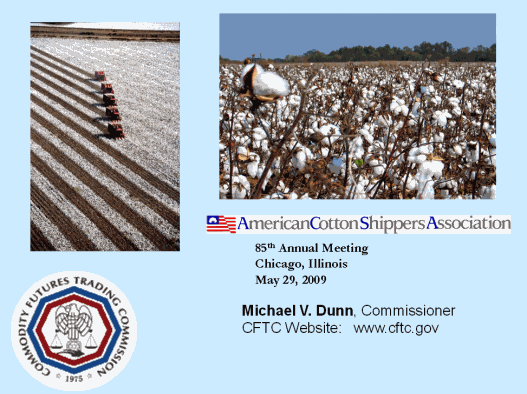
Thank you, I am happy to be here in Chicago today to address the 85th annual meeting of the American Cotton Shippers Association.
The last four months have been very busy for me serving as Acting Chairman of the CFTC, but I am happy to report that on Tuesday in our Washington office, President Obama’s nominee, Gary Gensler, was sworn in and became the 11th Chairman of the CFTC. I wish Gary the best of luck and will do all I can to ensure that he has a successful tenure and that the CFTC continues to fulfill its critically important mission. I will now be able to refocus my energies on the CFTC’s Agricultural Advisory Committee that I chair, and specifically the new subcommittee on convergence. Having sat on the Commission for over four years and having been involved in commodity and credit markets for far longer than I care to recall, I’d like to share my thoughts with you today on things we can do to ensure the viability and integrity of the commodity markets.
The American Cotton Shippers Association brings together merchants, primary buyers and mill service agents to promote the increased use of cotton in the U.S. and throughout the world. Your member firms handle 80% of the U.S. cotton sold in domestic and foreign markets. Your interaction with the CFTC arises from your use of cotton futures and options contracts that allow you to lock-in a fair price for your crop and hedge risks associated with your operations. I recognize that market developments over the last year have caused many of you to wonder whether or not the markets are functioning properly. I appreciate your concerns regarding market integrity and note that on April 22, 2008, during a Commission Agricultural Roundtable, cotton market participants raised concerns over volatility in the cotton futures and options markets that directly led to an ongoing CFTC investigation. I am also thankful that many in cotton industry have weighed in on the Commission’s hedge exemption concept release.
Today I would like to talk to you about four issues that are important not only to you as users of the cotton contract, but to everyone using the markets we regulate.
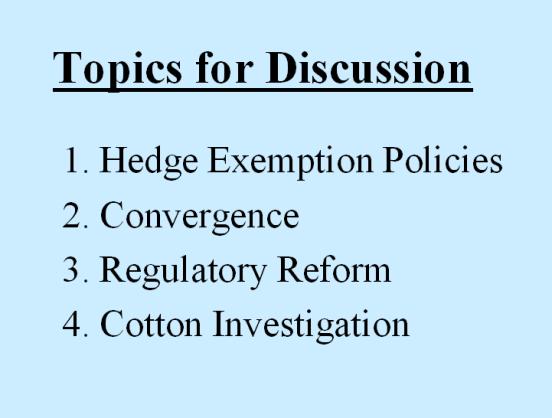
1. Hedge Exemption Policies
Increasing market transparency is critical given that the past year has seen record price swings in commodities coinciding with a huge influx of money from new classes of investors such as index funds. Justifiably these events have inspired questions and significant concern from the public and Congress.
On March 24, 2009, the Commission issued a concept release seeking public comments on how the Commission should consider revising the way it classifies commercial and speculative traders and how it issues exemptions to speculative position limits for hedgers. The CFTC’s September 2008 staff report on Index Traders and Swap Dealers made recommendations, including that the agency review the bona fide hedge exemptions for swap dealers. The report’s recommendations included considering a limited risk management exemption for swap dealers with reporting requirements and position limits.
Preparing for this conference, I reviewed the comments filed by the ACSA as well as the National Cotton Council and the Plains Cotton Cooperative Association on the hedge exemption concept release. In your comment letter, the ASCA stated that swap dealers should not be allowed to qualify for an exemption under the existing bona fide hedge definition and that only “bona fide commercial entities actually producing, processing, merchandising, manufacturing or consuming the physical commodity” should qualify for a hedge exemption. You were for the creation of a limited risk-management exemption for swap dealers provided that there was detailed reporting, aggregating of positions, and strict oversight by the CFTC. Speaking with many of you over the course of the last year, I have heard on more than one occasion that you believe that speculative trading by swap dealers has caused the cotton market and other agricultural markets to function improperly and this is a cause of great concern to me.
There are no generally accepted models that answer the question of whether speculative trading, easy credit, or “irrational exuberance” led to long term price distortions or a “bubble” last year. We still do not fully understand, even with all the data the CFTC has collected and analyzed, exactly how these factors worked together and how individual factors contributed to the overall problem.
We do know the data we collect and the studies we have done thus far have not conclusively shown that investment by speculative or index traders is directly driving prices. We look for those types of relationships on a daily basis—but we do it in a limited way. We look at whether current market conditions or market structures are leading to problems with price discovery or price distortions. Where we see problems, we intervene, working with the exchanges and traders to address those problems. Where we see fraud or manipulation, we bring enforcement cases.
As we continue to examine last year’s events, I believe that we can, and must, take pragmatic steps to address serious concerns. We must increase transparency in markets so both the CFTC and the public have a clear window into the potential factors driving price discovery. More transparency in supplies and storage and more transparency into market makeup will help market participants make better decisions.
Given the high percentage of open interest attributable to noncommercial positions speculative trading in some of our markets, I believe that a careful review of speculative positions limits is required. We all know that a healthy futures market has to have some level of speculation. Without speculation, futures markets just don’t work. How does one determine how much speculation is “just right” and how much leads to a market disruption?
In some of our markets, particularly agricultural markets, we have noted potential structural problems. These problems, such as lack of convergence, weak basis, and high margin requirements jeopardize the markets’ effectiveness as a risk management tool for the agricultural sector.
2. Convergence
I am sure many of you have seen these charts before or our following the information they present very carefully.
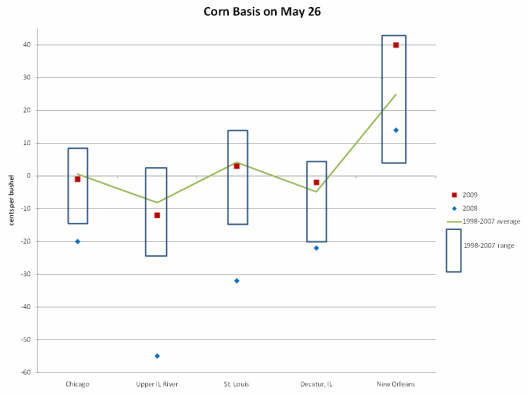
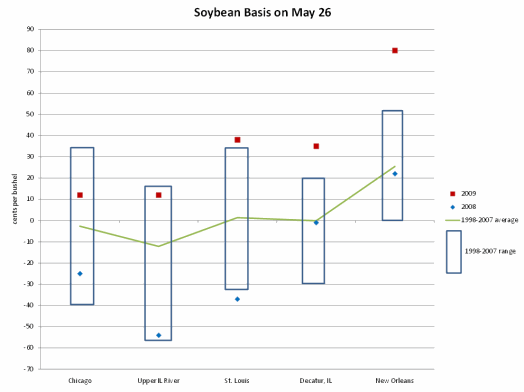
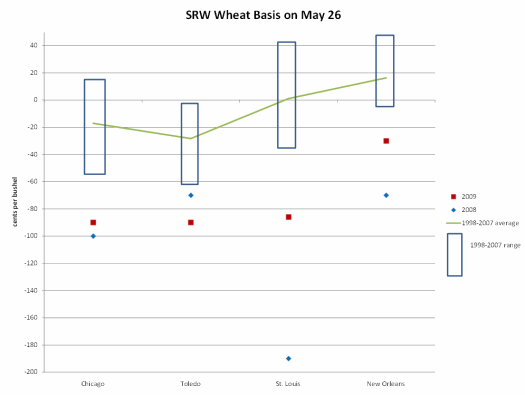
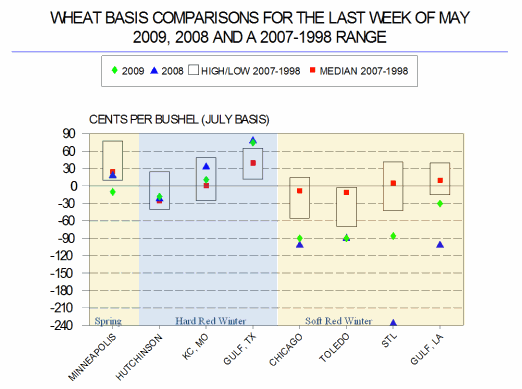
Some market participants believe that index trading is a significant cause of a lack of convergence in combination with other market factors. They believe that the nature of the physical supply of agricultural commodities means that index funds are causing an upward impact on prices either through high demand for long futures contracts or through impacts upon the cash markets
We have to take these concerns seriously. There have, of course, been periodic problems with convergence and basis in the agricultural markets over the years. But, we cannot rule out that speculative trading, including the periodic roll of index fund positions may be contributing to the problems we see today.
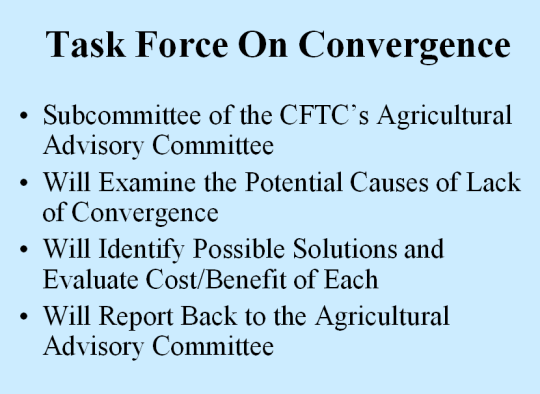
On March 9, 2009, the CFTC posted a Federal Register Notice seeking nominations to the Subcommittee on Convergence in Agricultural Commodity Markets, a new Subcommittee of the CFTC’s Agricultural Advisory Committee. It is my hope that the Subcommittee on Convergence, whose members were announced on April 24, 2009, will bring together all relevant information on the potential causes of these problems and help investigate possible solutions that will restore the markets’ effectiveness as a risk management tool for the agricultural sector.
The Subcommittee on Convergence will conduct at least three sessions to examine the causes, potential remedies, and suggested actions to remedy lack of convergence. The sessions are planned for the first half of 2009 and will be open to the public. The Subcommittee will present a report with its findings and recommendations to the Agricultural Advisory Committee, which will consider the report and make recommendations to the CFTC as to what further actions warrant consideration. If you have any issues with any of the recommendations the Subcommittee develops please send complaints directly to your President, Joe Nicosia, who is a member of the Subcommittee.
3. Regulatory Reform
As we sit here today, I think it is safe to say that last year exposed many problems in our financial regulatory system and that 2009 must be a year that seeks solutions.
I believe that all of us, regulators and market participants both here in the United States and abroad, were laboring under the belief that we could guard against systemic financial risks by relying on sophisticated investors and institutions to monitor their own counterparty risk. This theory was proven false with tragic consequences and untold hardship for many Americans who are now making hard choices while watching the nest egg they have spent their lives building rapidly fall apart.
Congress and the Administration are now examining what went wrong, what needs to done to stabilize and stimulate our economy, and what changes need to take place in our financial regulatory systems to ensure that we are never placed in this situation again. Many theories are developing as to what financial regulatory regime is needed, both domestically and internationally, to address the current crisis.
As an independent regulatory agency, I don’t believe that the CFTC must wait for Congress or the administration to tell us to start addressing key issues. I believe the CFTC can examine the following steps to ensure its markets are functioning properly and are protected against fraud and manipulation.
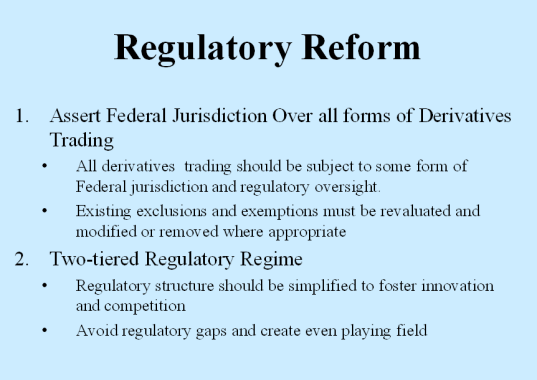
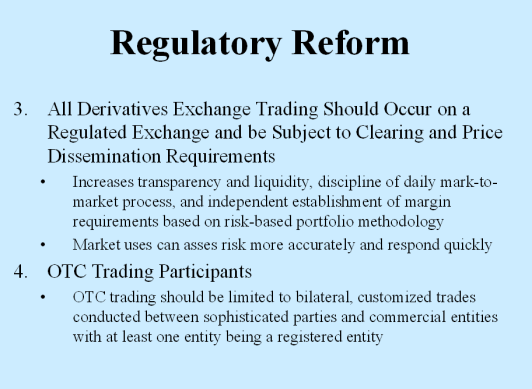
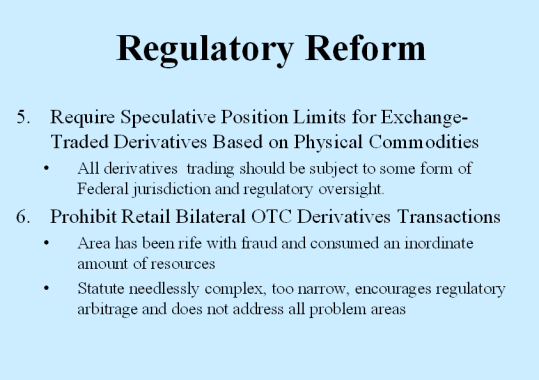
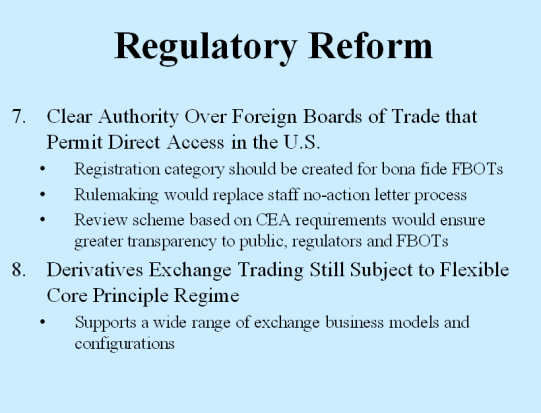
4. Cotton Investigation
As you all are undoubtedly aware, on June 3, 2008 the CFTC took the extraordinary step of disclosing that its Division of Enforcement has been conducting an ongoing investigation of the February/March 2008 price run-up in the cotton futures markets due to unprecedented market conditions and concerns expressed by market participants at the Commission’s agriculture roundtable. Although the Division of Enforcement has not publicly announced its findings, their review of this matter has been exhaustive. To date Enforcement staff has:
• Analyzed approximately 250,000 futures and options contracts that took place over the time period in question
• Analyzed various participants’ positions over several months
• Analyzed the bid and offer stacks on the days the market locked limit up
• Subpoenaed trading information from significant long and shorts, including swap positions and trades
• Hired an expert to review trade data
• Took sworn testimony of numerous market participants
The Division of Enforcement has also reviewed and examined several theories of possible manipulation including:
• Large Long Futures Holders: whether participants holding large long positions sought to raise the price of cotton futures to benefit their position
• Option Sellers: whether a trader or group of traders sought to lock the futures contract for the purpose of driving volume into the options trading, and hoping to sell off their established positions at high prices
• Active Traders During Critical Periods: whether the futures and options trading activity and positions of the market participants who were buying futures during the time periods leading up to the point when the market locked limit up and there were significant price movements in the options market
• Cash Market Manipulation: whether a significant holder of physical cotton with a significant long position of cotton futures sought to drive futures prices up
• Swaps Dealers Manipulation: whether swaps dealers may have been engaged in manipulation to benefit their swaps positions
While I cannot divulge to you today any conclusions reached from the staff’s investigation, I am confident that very shortly the CFTC will be issuing a report detailing its findings. Once that report is released, I look forward to working with you all to ensure that any necessary policy decisions needed to make sure that this contract is operating properly are acted on swiftly.
Thank you again for having me here today. I’m grateful to have had the opportunity to share my vision for reforms and I look forward to your feedback during the course of this valuable conference.
Last Updated: June 10, 2010
